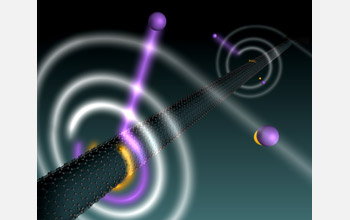Multimedia Gallery
Ionizing Atoms With a Nanotube
Launched, laser-cooled atoms are captured by a single-suspended, single-walled carbon nanotube charged to hundreds of volts. A captured atom spirals toward the nanotube (white path) and reaches the environs of the tube surface, where its valence electron (yellow) tunnels into the tube. The resulting ion (purple) is ejected and detected, and the dynamics at the nanoscale are sensitively probed.
In a paper written and published by graduate students Anne Goodsell and Trygve Ristroph, with Professors Lene Hau and Jene Golovchenko, Harvard University, the researchers report the first experimental realization of a combined cold atom-nanostructure system that represents a new paradigm at the interface of these two disciplines. Atoms are laser cooled to microkelvin temperatures and then launched towards a single, freely suspended carbon nanotube charged to hundreds of volts. The nanotube acts as a black hole. Atoms are attracted to the nanotube from distances of more than a hundred times the tube diameter, and spiral towards the tube under dramatic acceleration, with orbit times reaching just a few picoseconds. Close to the nanotube, an atom's valence electron tunnels into the tube, converting the atom into an ion that is ejected at high energy and easily detected. The system demonstrates sensitive probing of atom, electron and ion dynamics at the nanoscale, and opens the door to a new generation of cold atom experiments and nanoscale devices. [Research supported by a grant from the National Science Foundation.] (Date of Image: 2010)
Credit: Anne Goodsell and Tommi Hakala, Hau Lab, Harvard University
See other images like this on your iPhone or iPad download NSF Science Zone on the Apple App Store.
Images and other media in the National Science Foundation Multimedia Gallery are available for use in print and electronic material by NSF employees, members of the media, university staff, teachers and the general public. All media in the gallery are intended for personal, educational and nonprofit/non-commercial use only.
Images credited to the National Science Foundation, a federal agency, are in the public domain. The images were created by employees of the United States Government as part of their official duties or prepared by contractors as "works for hire" for NSF. You may freely use NSF-credited images and, at your discretion, credit NSF with a "Courtesy: National Science Foundation" notation.
Additional information about general usage can be found in Conditions.
Also Available:
Download the high-resolution JPG version of the image. (1.2 MB)
Use your mouse to right-click (Mac users may need to Ctrl-click) the link above and choose the option that will save the file or target to your computer.

